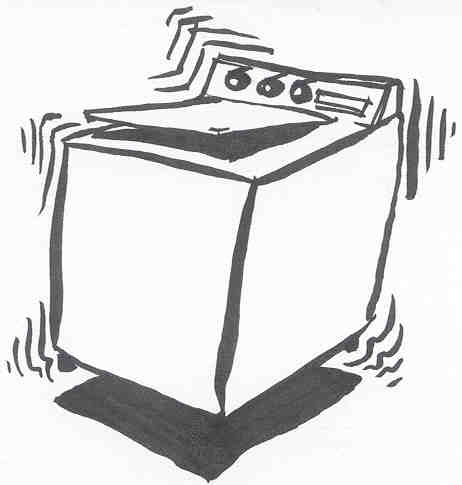2003.09.22 The Perfect Load
Here I was, just sitting at my computer trying to compose a new rant, when IT struck:
THE PERFECT LOAD

Before starting to work on my web page, I had started the catastrophic chain of events. The first load of laundry was still in the dryer, and the second load was underway. My jeans. Being a freak of nature, I have difficulty finding jeans that are long enough - I require a 35" inseam. Since this size does not exist, most of my jeans are actually 36" inseam. Adding to their mass is the fact that disappointingly few jeans with legs that long have narrow enough waists, so they often have additional fabric that I cinch up with my belt. These larger-than-normal jeans were not alone either - accompanying them were a couple long-sleeve shirts that I didn't think would fit into the last load.
The packed washer, filled with cotton and a little bit of water and detergent agitated normally enough - the cotton having virtually neutral buoyancy. Some time during the agitation, however, things started to go awry. A normal load of laundry, when finished the agitation phase, drains most of the water out of the tub, then spins the load to remove even more water by centripetal force. Usually, normal statistical distribution of articles flowing around the drum makes the load homogenous enough such that the spinning phase is balanced enough. The jean load, however, consisted of relatively few articles, and their distribution at the beginning of the spinning phase was clearly not balanced.
A horrific shaking and thumping aroused my interest - not just the clamour but also by a disturbing vibration that I could feel through the floor. Before I could respond, it was gone.
One of the design features of modern washing machines is that they have a trip switch built into the lid such that opening the device stops the spinning. This is a safety feature to avoid injury. When I got down to the washing machine, I noticed that the lid was slightly ajar. I opened the lid fully, to inspect the contents.
The load must have been so out of balance that it caused the drum to rattle the lid open and trip the safety feature. During my inspection, I pulled out the first article I could see, then put it back to see just how unbalanced it actually was. Unfortunately, I could only see the far side of the drum, but deposited the article on the near side, where most of the load already was - thus unbalancing it further.
When I dropped the lid down, the spinning cycle resumed. This time, with the full fury of a perfectly unbalanced load.
The sheer magnitude of the oscillating quickly exceeded the previous thumping, and slammed the washer back and forth inside its closet. It was probably at this point that the outer casing of the device was plastically deformed such that the lid could no longer open, and the safety shut off could no longer function. Horrified, I threw myself at the machine, trying to dampen it's vibrations and to pull the lip open to quell its motion. It batted me around like a rag doll in an industrial eggbeater.
Savaged and broken, all I could do was watch in terror as the cataclysmic shaking increased. Cracks started forming in the walls and floors, and bits of masonry started falling past the windows. Car alarms started going off in the parking lot. In the distance, air raid klaxons started blaring. Then, with a penultimate wrench, the perfectly mis-loaded washing machine tore itself from the closet... and died. The bastard runs on electricity, and the wires didn't reach.